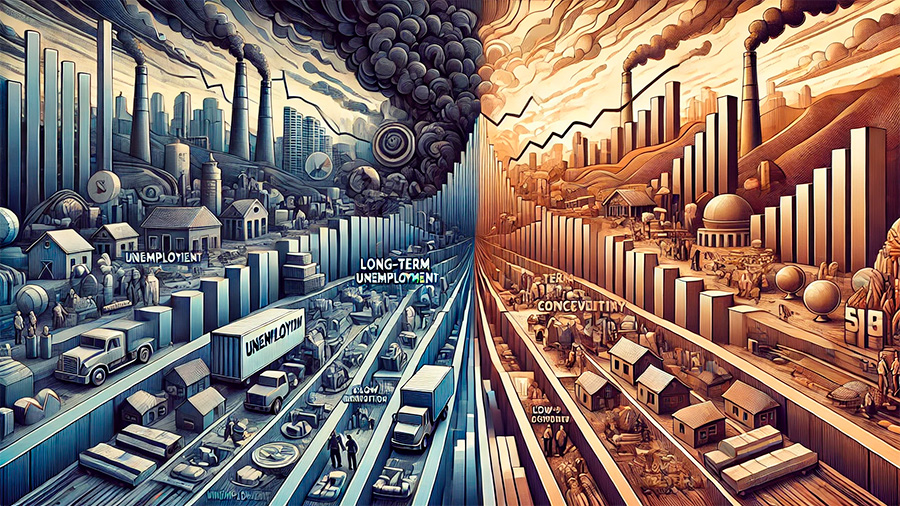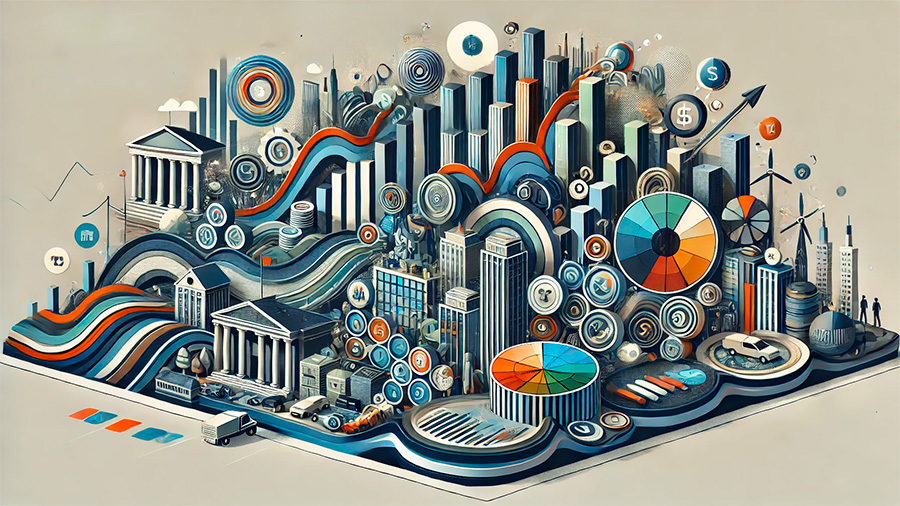Economic stagnation refers to a prolonged period of slow or no growth in an economy. Unlike recessions, where economic activity sharply declines, stagnation is characterized by minimal increases in GDP, high unemployment, and stagnant wages. The effects of economic stagnation can ripple across various sectors, influencing everything from employment to government policy. Understanding what causes economic stagnation and how it impacts both short- and long-term economic growth is essential for businesses, policymakers, and individuals alike.
Defining Economic Stagnation
Economic stagnation occurs when an economy fails to grow at a rate sufficient to keep up with population increases or productivity advances. This often leads to a reduction in per capita income, increased unemployment, and decreased consumer spending. Stagnation can last for several years or even decades, and it is typically marked by a combination of low demand, low investment, and weak overall economic performance.
Key Characteristics of Economic Stagnation
- Minimal GDP Growth: One of the defining features of stagnation is the lack of substantial growth in gross domestic product (GDP). While the economy may not be contracting, it grows at such a slow rate that it fails to create new jobs or improve living standards.
- High Unemployment Rates: Economic stagnation often results in high or persistent unemployment. When businesses are not growing, they tend to reduce hiring or even lay off workers, leading to fewer job opportunities.
- Stagnant Wages: In a stagnant economy, wage growth slows or halts altogether. This lack of wage increases diminishes the purchasing power of workers, leading to reduced consumer demand, which further suppresses economic growth.
- Low Consumer and Business Confidence: During periods of stagnation, both consumers and businesses are less likely to spend or invest. Uncertainty about the future makes businesses reluctant to expand, while consumers tend to save rather than spend, exacerbating the problem.
Causes of Economic Stagnation
Several factors can lead to economic stagnation, ranging from structural issues within an economy to external shocks. Understanding these causes helps explain why some economies fall into stagnation and struggle to recover.
Weak Demand and Consumption
One of the primary drivers of stagnation is weak demand for goods and services. When consumers are not spending, businesses experience lower sales, which reduces the incentive to produce more goods or hire additional workers. This lack of demand can stem from various factors, including high unemployment, stagnant wages, or an aging population with lower consumption needs.
In many cases, stagnation is self-reinforcing: low consumer demand leads to lower production, which in turn results in fewer jobs and even lower demand. This cycle can be difficult to break without external intervention or significant economic reform.
Insufficient Investment
Another key factor in economic stagnation is a lack of investment, both from the private sector and the government. Businesses may be reluctant to invest in new technologies, expansion, or innovation if they are uncertain about future economic growth or if demand for their products remains weak. Similarly, when governments do not invest in infrastructure, education, or other areas that stimulate growth, it can contribute to stagnation.
Low levels of investment stifle productivity improvements, further dampening growth prospects. Without sufficient investment in the future, economies can fall into a cycle of low growth and low innovation.
Demographic Changes
Demographic shifts, such as an aging population, can also contribute to economic stagnation. As a larger portion of the population retires, there is a reduced number of people in the workforce, which can slow overall productivity and economic output. Additionally, older populations tend to spend less, leading to weaker demand for goods and services.
In countries where birth rates are declining, the shrinking workforce may not be able to support economic growth. This is particularly challenging for economies that rely on consumer spending as a key driver of growth.
Technological Stagnation
Another factor that can contribute to economic stagnation is the lack of significant technological advancement. Historically, breakthroughs in technology have been key drivers of economic growth, leading to new industries, job creation, and productivity improvements. However, when economies fail to innovate, they risk falling into stagnation.
In some cases, existing industries may become more efficient without creating new opportunities for growth. For example, automation may lead to higher productivity but fewer jobs, which can reduce overall economic activity if displaced workers are unable to find new employment in emerging sectors.

Long-Term Effects of Economic Stagnation
The effects of economic stagnation are far-reaching and can have lasting impacts on both individual livelihoods and broader economic structures. Prolonged stagnation often requires significant policy intervention to reverse, and even then, recovery can be slow and uneven.
Increased Income Inequality
One of the most significant long-term effects of economic stagnation is the widening of income inequality. During periods of stagnation, wage growth is typically concentrated among higher-income earners, while the majority of workers experience little to no increase in their incomes. This leads to a greater concentration of wealth at the top, while the middle and lower classes struggle to maintain their standard of living.
As income inequality grows, it can further suppress consumer demand, as lower-income households have less disposable income to spend on goods and services. This creates a vicious cycle where economic growth remains stunted.
Higher Unemployment Rates
Long-term economic stagnation often results in persistently high unemployment rates. As businesses struggle to grow, they are less likely to hire new employees, leading to fewer job opportunities across the economy. Additionally, stagnation can result in structural unemployment, where workers’ skills no longer match the needs of the job market due to shifts in industries or technologies.
Prolonged unemployment can have long-term consequences for individuals, including the loss of skills, reduced earning potential, and increased reliance on government assistance programs.
Decreased Innovation and Competitiveness
An economy stuck in stagnation is less likely to foster innovation and maintain global competitiveness. Businesses may be less willing to invest in research and development if there is little incentive to innovate due to weak consumer demand or uncertain economic conditions. Over time, this can lead to reduced productivity, fewer new products, and a decline in the country’s competitive standing in the global marketplace.
Without significant technological advancements or industrial growth, stagnation can make it difficult for an economy to remain competitive in an increasingly globalized world.
Fiscal Strain on Government Budgets
Economic stagnation also places a strain on government budgets. With slower growth, tax revenues may decline, making it harder for governments to fund essential services and social programs. At the same time, the demand for government assistance, such as unemployment benefits or social security, may increase as more people are out of work or earning lower wages.
To counteract the effects of stagnation, governments may resort to borrowing or increasing public debt to fund stimulus programs or maintain public services. However, without strong economic growth to offset this borrowing, the fiscal strain can lead to long-term budget deficits and financial instability.

Policies to Combat Economic Stagnation
Addressing economic stagnation requires a combination of policies designed to stimulate demand, boost investment, and promote innovation. Governments, central banks, and international organizations often work together to implement measures aimed at breaking the cycle of stagnation.
Monetary Policy and Interest Rates
One of the primary tools used to combat economic stagnation is monetary policy, particularly through the manipulation of interest rates. Central banks may lower interest rates to encourage borrowing and investment, making it cheaper for businesses and consumers to take out loans. This can stimulate demand and lead to increased economic activity.
However, monetary policy alone may not be sufficient to address stagnation, particularly in cases where businesses and consumers are reluctant to spend despite low interest rates.
Fiscal Stimulus
Governments can also use fiscal stimulus to combat stagnation by increasing public spending on infrastructure, education, and healthcare. These investments can create jobs, boost demand, and lay the foundation for long-term economic growth. Additionally, tax cuts or direct payments to consumers can encourage spending, further stimulating the economy.
However, fiscal stimulus must be carefully managed to avoid increasing public debt to unsustainable levels. Long-term economic reforms may be needed to address the underlying causes of stagnation.
Encouraging Innovation and Investment
To break out of economic stagnation, economies need to foster innovation and attract investment. Governments can support innovation by funding research and development, offering tax incentives for businesses to invest in new technologies, and creating an environment that encourages entrepreneurship.
Investing in education and workforce development can also help economies adapt to new technologies and industries, reducing structural unemployment and boosting productivity.
Conclusion: The Importance of Addressing Economic Stagnation
Economic stagnation can have far-reaching and long-lasting effects on both individuals and the broader economy. From rising income inequality to reduced innovation and global competitiveness, the impacts of stagnation require careful management and coordinated policy responses. Understanding the causes of economic stagnation and its long-term effects is essential for addressing this challenge and ensuring sustained economic growth in the future. Through targeted investments, policy reforms, and efforts to stimulate demand, governments and businesses can work to overcome the obstacles of stagnation and build a more resilient and dynamic economy.
